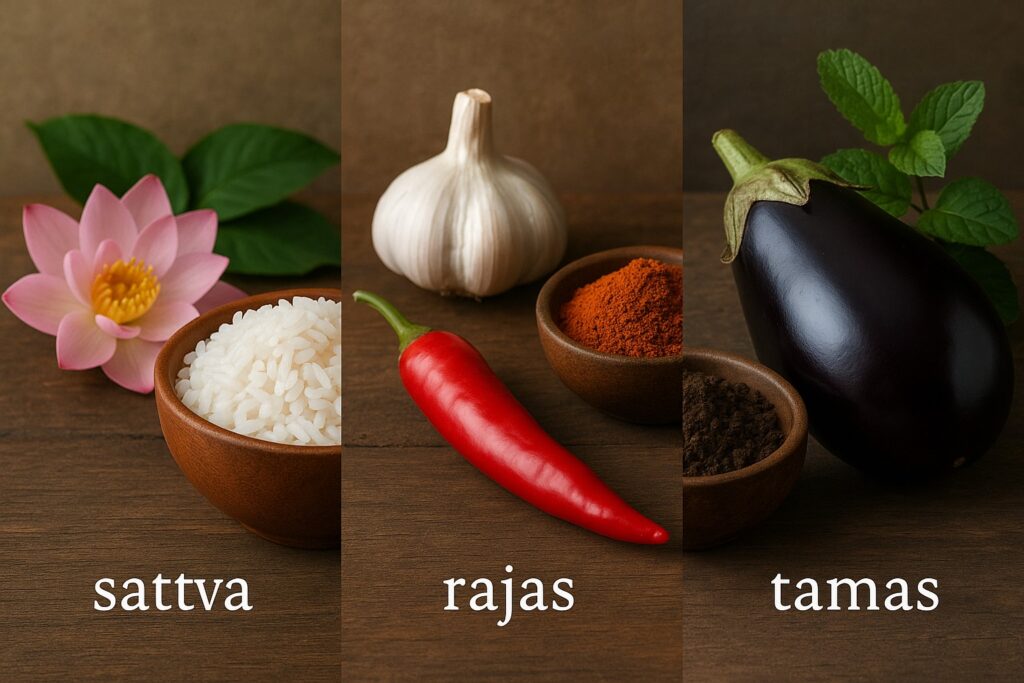
From the ancient wisdom of Ayurveda comes a deep understanding of food that reaches far beyond our knowledge of proteins, carbohydrates, fats, vitamins, minerals and trace elements. Food is more than fuel for our body – it is a vital force that shapes our thoughts, emotions, and spiritual awareness. At the heart of this understanding lies the concept of the three gunas, or qualities/characteristics that exist in all of nature, including the food we eat and how it influences our well-being on subtle and profound levels.
The three gunas include Sattva, which represents purity, Rajas, which represents activity, and Tamas, which represents inertia. In this article, we will learn about each of the gunas and how they can be applied to our dietary choices, thus helping us to create a life of harmony, happiness, balance, vitality, and clarity.
Sattvic Food: The Path of Clarity and Harmony
Sattva refers to purity, balance, peace, and light. Sattvic foods nourish our body without being overly stimulating. They promote mental calm and clarity, emotional stability, natural joy, and spiritual growth.
The Characteristics of Sattvic Food:
- Fresh, natural, and organic
- Filled with prana (life force)
- Light, easily digestible
- Prepared with love and mindfulness
- Balanced in taste and nutrition
Examples:
- Fresh organic fruits and vegetables
- Whole grains such as rice, oats, millet, buckwheat, whole wheat and quinoa
- Legumes like lentils, mung beans, chickpeas, and a variety of daal
- Nuts and seeds
- Fresh dairy such as milk, buttermilk and ghee
- Mild spices like turmeric, cumin, and ginger
- Herbal teas and pure water
- Natural sweeteners such as raw honey, date syrup, and jaggery
Sattvic food is extremely important to the yogic diet and is considered ideal for those pursuing meditation, self-awareness, and a harmonious life.
Rajasic Food: The Fire of Passion and Restlessness
Rajas is the guna of movement, energy, and stimulation. Rajasic foods are naturally more stimulating, invigorating and energizing, but when consumed excessively, they can lead to restlessness, occasional anxiety, and emotional agitation.
The Characteristics of Rajasic Food:
- Spicy, salty, or sour
- Stimulating, sometimes to excess
- Overly-processed, heavily seasoned and spicy
Examples:
- Spicy curries
- Deep fried, salty snacks
- Caffeinated beverages such as coffee, black tea and some sodas
- Eggs and chocolate
- Onions and garlic (according to traditional yogic texts)
Rajasic foods can serve as a helpful stimulus for people with active lifestyles and demanding routines, but they can also agitate the mind and disrupt our sense of inner calm if not properly balanced with sattvic foods.
Tamasic Food: The Weight of Inertia and Confusion
Tamas is the guna of darkness, inertia, and decay. A diet that relies on tamasic foods can dull the senses, cloud the mind, and contribute to sluggishness, depression, and feelings of disconnection.
The Characteristics of Tamasic Food:
- Stale, overcooked, rancid or spoiled
- Heavily processed and chemically preserved
- Draining rather than energizing
Examples:
- Leftovers, especially after a day. Ayurveda teaches us that the longer our food sits in the refrigerator, the older it gets, the less prana (life force) it contains, and the more tamasic it becomes
- Canned and frozen foods
- Meats and alcohol
- Excessively fatty and sugary foods
- Fermented foods may also be tamasic, although naturally fermented vegetables and cultured dairy products can be beneficial, particularly for people who are predominately VATA dosha, or who seek to balance VATA with the sour taste
- Tobacco and intoxicants
A diet high in tamasic foods can lead to physical lethargy, stagnation, and mental dullness. Those seeking clarity, vitality, and spiritual progress are advised to minimize tamasic foods and influences.
Why the Guna of Our Food Matters
In the yogic tradition, you are what you eat is not just a metaphor—it’s a principle. The quality of our food directly impacts the quality of our thoughts, energy, and consciousness.
- Sattvic foods support meditation, compassion, and clarity.
- Rajasic foods fuels ambition, drive, and activity, but can also lead to imbalance.
- Tamasic foods anchor us in inertia and confusion, making it harder to experience joy, lightness of being, and awareness.
By becoming more mindful of the gunas in our diet, we begin to take responsibility for not just our physical health, but for our inner world as well.
Living a Guna-Balanced Life
While the ideal in yoga and Ayurveda is to cultivate Sattva, this doesn’t mean completely avoiding all Rajasic or Tamasic foods. Life is dynamic! There is a time and place for all three gunas in our diet, however, the key lies in awareness and intention.
Practical Tips:
- Begin the day with a sattvic breakfast of fresh seasonal fruits, cooked grains, fresh milk, ghee and hot herbal tea.
- Prepare meals with gratitude and mindfulness. Remember: Our state of mind when cooking and handling food permeates the food!
- Eat at regular times; avoid overeating and eating late at night.
- Reduce overly stimulating (rajasic) foods such as coffee, deep fried, and super spicy foods, especially at night.
- Favor fresh, home-cooked meals over fast and packaged food as much as possible. When choosing fast foods, make the best, freshest choices possible.
Conclusion
Understanding food through the lens of the three gunas reveals how every bite we take shapes not just our body, but our mind and spirit as well. Choosing mostly sattvic foods, and balancing rajasic and tamasic tendencies, allows us to align our diet with our highest intentions—whether for health, peace, or spiritual awakening.
Let food inspire us as it becomes our ally on the path to wholeness, awareness, and joy!


Leave a Reply